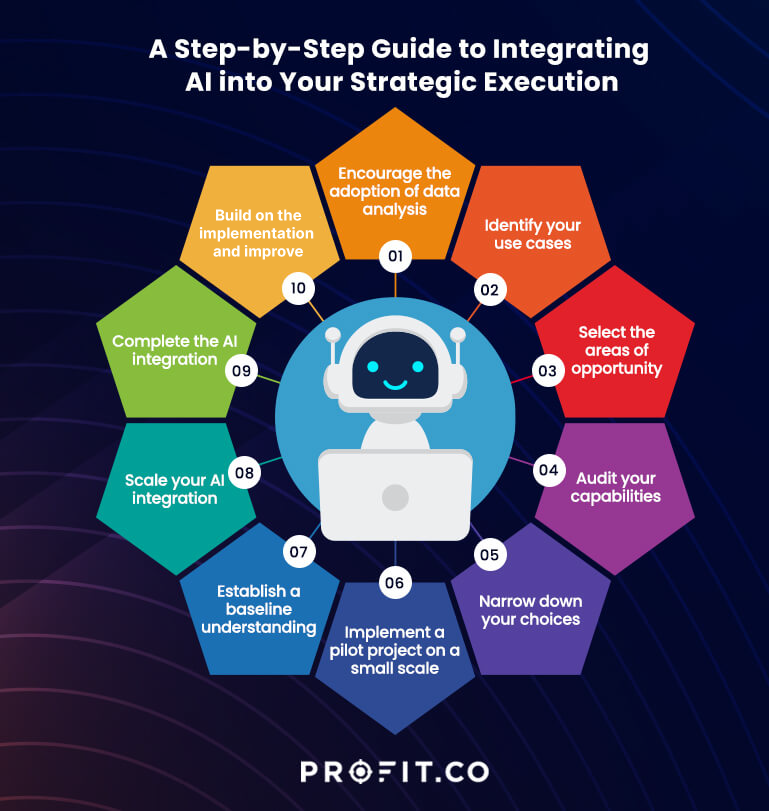
Unlocking the Future: A Beginner’s Guide to D. AI Strategy & Implementation
In today’s rapidly evolving digital landscape, Artificial Intelligence (AI) is no longer a futuristic concept but a present-day imperative for businesses of all sizes. From automating mundane tasks to uncovering profound insights, AI is reshaping industries and redefining competitive advantage. But simply "doing AI" isn’t enough. To truly harness its power, organizations need a well-defined D. AI Strategy and a robust plan for its Implementation.
This comprehensive guide will demystify what D. AI Strategy & Implementation means, why it’s crucial for your business, and how you can embark on your AI journey, even if you’re a complete beginner.
What is "D. AI Strategy & Implementation"?
Let’s break down the term:
- D. AI: The "D." in D. AI typically refers to Digital AI or Data-driven AI. It emphasizes that AI initiatives are deeply intertwined with an organization’s digital transformation journey and are fundamentally powered by data. It’s about leveraging AI to enhance digital processes, create digital products, and make data-informed decisions across the entire digital ecosystem.
- Strategy: This is your "roadmap" for AI. It’s about defining why you want to use AI, what problems you want to solve, how AI will align with your overall business goals, and what resources you’ll need. A good strategy ensures your AI efforts are purposeful, not just random experiments.
- Implementation: This is the "doing" part. It involves the practical steps of bringing your AI strategy to life. This includes collecting and preparing data, choosing the right technologies, developing or acquiring AI models, integrating them into your existing systems, and managing the people and processes involved.
In essence, D. AI Strategy & Implementation is about building a thoughtful, data-centric plan for adopting and integrating AI technologies to achieve specific business outcomes, and then executing that plan effectively.
Why is a D. AI Strategy Essential for Your Business?
You might be thinking, "Can’t I just buy some AI software and get started?" While you can, without a strategy, your AI efforts are likely to be fragmented, inefficient, and fail to deliver significant value. Here’s why a well-defined D. AI strategy is critical:
- Clear Business Alignment: AI isn’t magic; it’s a tool. A strategy ensures you’re using AI to solve real business problems (e.g., reducing customer churn, optimizing supply chains, improving product design) rather than just experimenting for technology’s sake.
- Optimized Resource Allocation: AI initiatives can be costly in terms of time, money, and talent. A strategy helps you prioritize projects, allocate resources wisely, and avoid wasted investments.
- Risk Mitigation: AI comes with its own set of risks, including data privacy concerns, ethical dilemmas, and potential biases. A strategy helps you identify and mitigate these risks proactively.
- Competitive Advantage: Companies with a clear AI vision are better positioned to innovate, outpace competitors, and respond faster to market changes.
- Scalability and Sustainability: A strategic approach ensures that successful pilot projects can be scaled across the organization and that AI capabilities are built for long-term growth and evolution.
- Enhanced Decision-Making: By integrating AI insights into your core processes, your strategy empowers better, data-driven decisions at every level of your organization.
The "D." in D. AI: Digital and Data-Driven Foundation
The "D." is crucial because AI thrives on digital data. Your D. AI strategy must therefore consider:
- Data Collection & Quality: Do you have enough high-quality, relevant data to train AI models? Is it accessible and properly managed?
- Digital Infrastructure: Do you have the cloud computing power, storage, and networking capabilities to support AI workloads?
- Digital Processes: How will AI integrate with and enhance your existing digital workflows, customer interfaces, and internal operations?
- Digital Transformation Maturity: How far along is your organization in its overall digital transformation journey? AI often accelerates this journey.
Key Pillars of a Robust D. AI Strategy
Building an effective D. AI strategy isn’t a one-time event; it’s an ongoing process that involves several interconnected pillars:
-
Vision and Business Goals:
- Define "Why": What specific business problems are you trying to solve with AI? (e.g., "reduce customer service wait times by 30%", "predict equipment failure with 95% accuracy").
- Align with Business Strategy: Ensure AI initiatives support your overall company objectives.
- Identify Opportunities: Look for areas where AI can create new value, not just automate existing tasks.
-
Data Foundation:
- Data Strategy: How will you collect, store, manage, and secure the vast amounts of data needed for AI?
- Data Quality: Implement processes to ensure data is accurate, complete, consistent, and relevant. "Garbage in, garbage out" is a fundamental truth in AI.
- Data Governance: Establish rules and responsibilities for data ownership, access, and usage.
-
Technology and Infrastructure:
- Cloud vs. On-Premise: Decide where your AI models will run (e.g., AWS, Azure, Google Cloud, or your own data centers).
- AI Tools & Platforms: Select appropriate machine learning platforms, development tools, and pre-built AI services (e.g., for natural language processing, computer vision).
- Integration Capabilities: Ensure new AI systems can seamlessly connect with your existing IT infrastructure (CRM, ERP, etc.).
-
Talent and Culture:
- Skill Gaps: Identify what AI skills you need (data scientists, ML engineers, AI ethicists) and how you’ll acquire them (hire, train, partner).
- Change Management: Prepare your employees for how AI will change their roles and workflows. Foster a culture of learning and experimentation.
- AI Literacy: Educate leaders and employees about AI’s potential and limitations.
-
Ethics, Governance, and Risk Management:
- Responsible AI Principles: Establish guidelines for fair, transparent, and accountable AI use. Address potential biases in data and algorithms.
- Regulatory Compliance: Ensure your AI initiatives comply with data privacy laws (like GDPR, CCPA) and industry-specific regulations.
- Security: Protect AI models and the data they use from cyber threats.
- Monitoring and Audit: Implement mechanisms to track AI model performance, identify drift, and ensure ethical adherence over time.
Implementing D. AI: A Step-by-Step Guide for Beginners
Once you have your strategy in place, it’s time to put it into action. Here’s a simplified roadmap for D. AI implementation:
Phase 1: Assessment and Planning
- Current State Analysis: Understand your existing data, technology infrastructure, and skill sets. Where are your strengths and weaknesses?
- Identify High-Impact Use Cases: Based on your strategy, pinpoint 1-3 specific problems that AI can realistically solve and deliver significant business value in the short term. Start small!
- Define Success Metrics: How will you measure the success of your AI project? (e.g., "20% reduction in call volume," "5% increase in sales conversion").
- Build a Cross-Functional Team: Bring together business users, IT specialists, data experts, and potentially external consultants.
- Develop a Detailed Project Plan: Outline timelines, resources, budget, and responsibilities for your first pilot project.
Phase 2: Pilot and Proof-of-Concept (PoC)
- Data Collection & Preparation: Gather the necessary data for your chosen use case. This often involves significant effort in cleaning, transforming, and labeling data.
- Model Development:
- Choose the Right AI Approach: Will it be machine learning, deep learning, natural language processing, or a combination?
- Build/Acquire Models: This might involve training models from scratch, fine-tuning pre-trained models, or leveraging AI services (e.g., Google Cloud Vision API for image recognition).
- Testing and Validation: Rigorously test your AI model with real-world data to ensure it performs as expected and meets your success metrics.
- Pilot Deployment: Deploy the AI solution in a limited, controlled environment (e.g., to a small group of users, a single department). Gather feedback and learn from real-world usage.
Phase 3: Scaling and Integration
- Refine and Optimize: Based on pilot feedback, iterate on your AI model and its integration.
- Full-Scale Deployment: Roll out the AI solution to a wider audience or across the entire organization.
- Integrate with Existing Systems: Ensure the AI solution seamlessly connects with your core business applications (e.g., CRM, ERP, customer portals). This might involve API development or middleware.
- User Training and Adoption: Train employees on how to interact with and leverage the new AI system. Communicate its benefits and address any concerns.
Phase 4: Monitoring and Optimization
- Continuous Monitoring: Track the performance of your AI models in real-time. Look for "model drift" (where accuracy declines over time due to changing data patterns).
- Performance Metrics: Regularly review the defined success metrics to ensure the AI solution is still delivering value.
- Feedback Loops: Establish channels for users to provide feedback, which can inform further improvements.
- Retraining and Updates: Periodically retrain your AI models with new data to maintain or improve accuracy and adapt to evolving conditions.
- Cost Optimization: Monitor the computing resources consumed by your AI solutions and optimize them for efficiency.
Phase 5: Governance and Continuous Improvement
- Establish AI Governance Framework: Formalize your ethical guidelines, data privacy policies, and responsible AI practices.
- Regular Audits: Conduct periodic reviews of AI systems for fairness, transparency, and compliance.
- Document Best Practices: Capture lessons learned from each AI project to inform future initiatives.
- Foster a Culture of Innovation: Encourage ongoing exploration of new AI technologies and use cases to maintain a competitive edge.
Common Challenges in D. AI Implementation and How to Overcome Them
While the promise of AI is great, the journey can have bumps. Here are common challenges and how to address them:
- Challenge: Poor Data Quality
- Solution: Invest in data governance, data cleaning tools, and dedicated data engineering teams. Start with smaller datasets if necessary, and focus on improving data hygiene early.
- Challenge: Lack of Skilled Talent
- Solution: Upskill existing employees through training programs, partner with AI consultancies, or recruit specialized data scientists and ML engineers.
- Challenge: Resistance to Change
- Solution: Communicate clearly about AI’s benefits, involve employees in the process, provide adequate training, and showcase early successes. Emphasize that AI is a tool to augment, not replace, human capabilities.
- Challenge: Ethical Concerns and Bias
- Solution: Implement responsible AI principles from the outset. Diversify your AI development teams, conduct bias audits on data and models, and ensure transparency in AI decision-making.
- Challenge: High Costs and Unclear ROI
- Solution: Start with small, high-impact pilot projects to demonstrate value quickly. Focus on measurable business outcomes, not just technology. Explore cloud-based AI services which often have pay-as-you-go models.
- Challenge: Integration with Legacy Systems
- Solution: Plan for robust APIs and integration layers. This often requires careful architecture design and collaboration between AI and traditional IT teams.
Real-World Examples of D. AI in Action
- Customer Service: AI-powered chatbots and virtual assistants handle routine queries, freeing up human agents for complex issues.
- Manufacturing: Predictive maintenance AI analyzes sensor data to anticipate equipment failures, reducing downtime and costs.
- Healthcare: AI assists in diagnosing diseases from medical images (e.g., X-rays, MRIs) and personalizes treatment plans.
- Retail & E-commerce: AI recommends products to customers, optimizes pricing, and manages inventory more efficiently.
- Finance: AI detects fraudulent transactions, assesses credit risk, and provides personalized financial advice.
The Future of D. AI
The D. AI landscape is continuously evolving with advancements in areas like Generative AI (e.g., ChatGPT, DALL-E), Federated Learning, and Explainable AI (XAI). A successful D. AI strategy is therefore not static; it must be agile and adaptable, embracing continuous learning and innovation.
Conclusion
Embarking on a D. AI journey can seem daunting, but with a clear strategy and a systematic implementation approach, your organization can unlock incredible value. By focusing on business problems, building a solid data foundation, fostering the right talent and culture, and prioritizing ethical considerations, you can transform your operations, delight your customers, and secure a competitive edge in the digital age.
Don’t wait for the future; build it with a thoughtful D. AI strategy and impactful implementation today.



Post Comment